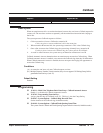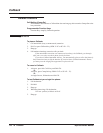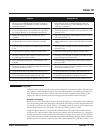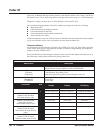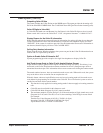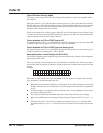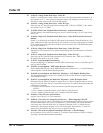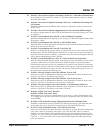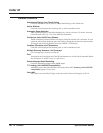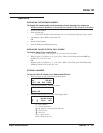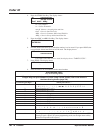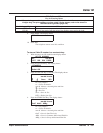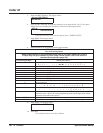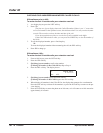
Caller ID
Aspire Software Manual Features ◆ 185
➻ 20-09-03 : Class of Service Options (Incoming Call Service) - Sub Address Identification
In an extension’s Class of Service, enable (1) or disable (0) the extension’s ability to display
the Caller Sub-Address.
➻ 20-09-04 : Class of Service Options (Incoming Call Service) - Notification of Incoming Call
List Existence
Determine whether or not the CHECK LIST message is displayed to indicate a missed call
(0=off, 1=on).
➻ 20-13-06 : Class of Service Options (Supplementary Service) Automatic Off-Hook Signal
In order for a display phone to show Caller ID information for a second incoming call, must
be enabled (1).
➻ 20-19-01 : System Options for Caller ID - Caller ID Display Formatting
Determine whether the first 10 digits (0) or last 10 digits (1) should be displayed when Caller
ID exceeds 12 digits.
➻ 20-19-02 : System Options for Caller ID - Caller ID Wait Timer
Determine how long an incoming CO call should wait for Caller ID information from telco
before the system connects the call.
➻ 20-19-03 : System Options for Caller ID - Edit Caller ID
Enable (1) or disable (0) the system’s ability to add the trunk access code to the stored Caller
ID information. If Caller ID Edit Mode is disabled (0), no trunk access code will be added to
the Caller ID. If this option is enabled (1), the trunk access code entered in Program 10-02-05
will be added to the beginning of the Caller ID.
➻ 20-19-05 : System ID Options for Caller ID - Caller ID Sender Queuing Timer
With the Caller ID Sender Queuing option, determine how long an incoming call will wait in
queue for a DSP resource to become available (0-64800 seconds). If a resource becomes
available during this time, the call will immediately ring the SLT with Caller ID. If the timer
expires before a resource becomes available, then system rings the single line telephone with-
out Caller ID (until the timer expires, the SLT will not ring). If the queuing timer is set to "0",
the system does not queue the incoming call.
➻ 20-20-01 : Message Setup for Non-Caller ID Data - Private Call
Enter the text (up to 24 alphanumeric characters) to be displayed for Caller ID when a user
receives a call which is classified as a private call.
➻ 20-20-02 : Message Setup for Non-Caller ID Data - Out of Service Area
Enter the text (up to 24 alphanumeric characters) to be displayed for Caller ID when a user
receives a call which is classified as a an out-of-service area call.
➻ 20-20-03 : Message Setup for Non-Caller ID Data - Call Information with Error
Enter the text (up to 24 alphanumeric characters) to be displayed for Caller ID when a user
receives a call which is classified as a call with a CID error.
➻ 80-02-01 : DTMF Tone Setup - Duration
80-02-02 : DTMF Tone Setup - Pause
With Program 14-01-20 set to 1 and Program 14-02-10 set to 1, if the Caller ID block code
*67 is being sent too quickly for the telco to recognize, lengthen the pause and duration time
for the DTMFs.
➻ 81-01-04 : COIU Initial Data Setup - Ringing Signal Detection Minimum Time
If trouble is experienced receiving Caller ID, try reducing the ringing signal detection timer
(for example, set it to 6). Note, however, that this may cause false ring detections.
➻ 81-01-12 : COIU Initial Data Setup - Caller ID Detection Time
Select the Caller ID detection time. If an entry other than "0" is made, the actual waiting time
is the value x 64ms. For example, if the timer is set to 46, the COIU waits 46 x 64ms =
2944ms). If a problem exists with Caller ID displaying, the recommended entry to try first
would be "46". (0 = COIU waits 500ms from end of first ring to beginning of FSK signal for
Caller ID, 1 - 255 = The COIU waits for the Caller ID FSK signal from when the first ring
pulse was detected.)



